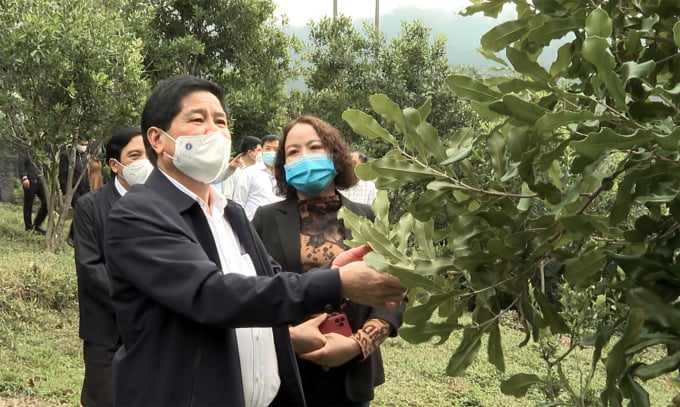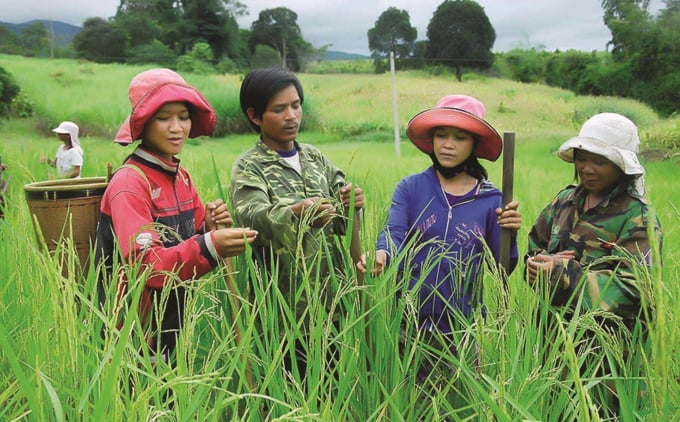May 30, 2025 | 10:07 GMT +7
May 30, 2025 | 10:07 GMT +7
Hotline: 0913.378.918
May 30, 2025 | 10:07 GMT +7
Hotline: 0913.378.918

Deputy Minister of Agriculture and Rural Development Le Quoc Doanh visiting the macadamia planting model in Northwest provinces in late 2021. Photo: Bao Thang.
Agroforestry farming practices have long existed in Vietnam. Some prime examples include the traditional shifting cultivation system of the ethnic minorities, the forest - garden - pond - barn and hill garden ecosystem in mountainous residential areas, the mangrove forest - aquaculture system in the coastal areas Central and Southern.
Particularly for the Northwest region, agroforestry is presented in intercropping short-term crops with forest trees when the planted forest has not yet closed its canopy; intercropping food crops and medicinal plants under the forest canopy; intercropping upland rice, cassava and groundnut with forest; raising cattle, grazing alternately under the canopy of planted forests.
These are measures that help many Northwest provinces in breaking the stance of short-term monoculture on sloping land. Maize and cassava plants help the soil reduce the occurrence of erosion, fertility loss, even degeneration and discoloration.
The Northwest has formed and developed many high economic efficiency agroforestry models, such as longan, maize, and grass growing model for livestock in Dien Bien, Son La, Yen Bai; hawthorns - maize planting model in Son La; macadamia, coffee, and soybean intercropping model in Dien Bien and Son La; acacia, mango, maize, and grass growing model for livestock in Yen Bai.
Dr. Pham Van Hoi, Director of the Center for Agricultural Research and Ecological Studies (CARES), Vietnam National University of Agriculture (VNUA), said that Northwestern provinces should first prioritize reducing plantation density and growing many types of trees in combination with grasses, annual plants, and livestock. “Within an area less than 1 ha, people should prioritize the development of cattle breeding. Only when the area reaches 2 ha or more should they combine livestock with fruit trees.
In the Thesis "Converting the shifting cultivation model into agroforestry model contributing to sustainable farming on sloping land in Northwest provinces", VNUA assessed that when spending VND 1 of capital to cultivate agroforestry models ethnic minorities can earn VND 3.3 - 14.1 after a business cycle depending on the model.
In addition to economic benefits, agroforestry models also provide social benefits, such as reducing the rate of forest loss and avoiding migratory farming.

Agroforestry farming not only breaks the position of maize monoculture but also helps farmers to increase their income.
Helping people soon increase their income and preventing soil erosion are two of the main goals when performing agroforestry models. There are these two models that guarantee this as of date.
The first is the longan -maize - grass growing model for livestock.
In this model, longan and livestock grass are included in the area under maize cultivation. Mulato grass is designed to be planted on the road along the band with a distance of 15m between each band. Longan is planted into two rows between the bands with a density of 240 plants/ha (5m row spacing, 5m tree spacing). Maize is intercropped between the grass bands (0.3 x 0.3m).
This system gives maize yield from 4.1 to 5.74 tons/ha/year. Longan begins to produce fruit from the fourth year, while the mulato yield gradually increases and remains stable at 14 to 15.2 tons/ha from the fourth year.
Farmers start to make a profit from the second year (about VND 6.1 million/ha). Initial investment (VND 44.2 million/ha) returns after the fourth year. The profit, coming in the 5th year onwards, is approximately VND 29.3 million/ha, more than two times higher than pure maize monoculture.

Shifting cultivation remains an important part of the livelihoods of many upland communities.
In the second model, teak and plum trees are introduced with the aim of providing long-term income for farmers, moving towards a complete replacement of maize, and the intercropping of soybean and guinea grass is included.
Guinea grass is designed to be planted along the band with a distance of 10m between each band. Teak and plum are planted next to the grass band. For every 1 row of teak, there would be 1 row of plum. The density is 204 trees/ha for teak (3m tree spacing) and 125 plants/ha for plum (4m tree spacing). The area between the bands is planted with coffee with a density of 1680 trees/ha (2m row spacing, 1.8m tree spacing). When the coffee has not closed its canopy, soybeans are intercropped.
Soybean and guinea grass will be the two crops that give income in the first year. Guinea gives an average yield of 16.5 tons/ha/year after one year. Coffee gives yield from the third year (2.2 tons/ha). Plum begins to bear fruit in the third year. Teak trees in the system will be harvested around the 15th year.
One thing to note is that this model brings profits right from the second year (VND 13.6 million/ha). Farmers recover their initial investment (VND 44.4 million/ha) after the third year, and the model will prove to be over 2 times more efficient than pure maize monoculture. From the fourth year onwards, the model is more likely to generate higher income as the coffee and plum trees mature with higher and more stable yields.
From these two models, agroforestry has affirmed its advantages in terms of economic efficiency in the long run.
Translated by Samuel Pham
/2025/05/25/4127-3-073637_820.jpg)
(VAN) Thanks to the promotion from an FAO-implemented project, vegetable production in greenhouses in Moc Chau has seen strong development, from 1.5 hectares in 2021 to nearly 50 hectares in 2024.

(VAN) FAO has recently supported USD 140,000 to implement the project 'Risk mitigation human-animal interface risks through disease control initiatives in pig farming.'

(VAN) The People's Committee of Tra Vinh province has approved an adjustment to the investment policy for the Green Hydrogen Plant project, increasing its area to approximately 52.76 hectares.
![Reducing emissions from rice fields: [2] Farmers’ commitment to the soil](https://t.ex-cdn.com/nongnghiepmoitruong.vn/608w/files/news/2025/05/05/dsc08881jpg-nongnghiep-140632.jpg)
(VAN) Clean rice cultivation model in Thuong Tan commune, Bac Tan Uyen district, is assisting local residents in achieving sustainable agriculture by substantially reducing costs, increasing productivity, and protecting the environment.

(VAN) At the conference to disseminate Resolution No. 68, AgriS introduced its digital agricultural ecosystem and reaffirmed its commitment to accompanying the Government in promoting private sector development and sustainable agriculture.

(VAN) 'Blue Ocean - Blue Foods' initiative is designed to restore marine ecosystems and establish sustainable livelihoods for local communities by cultivating a minimum of 1,000 hectares of cottonii seaweed in the first three years.
/2025/05/21/4642-3-112707_603.jpg)
(VAN) The V-SCOPE project has made direct contributions to three out of six pillars of the Comprehensive Strategic Partnership between Vietnam and Australia.